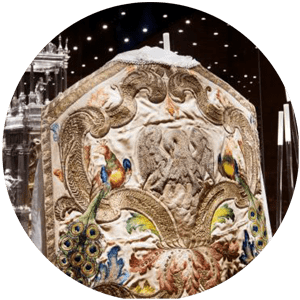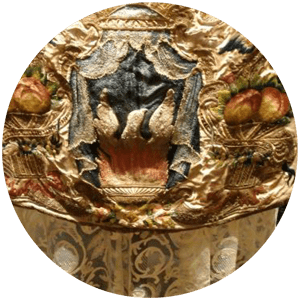After seeing the stairs within the walls, we are introduced into the 12th century tower promoted by Bishop Pedro de Librana after the conquest of Zaragoza in 1118. In the room centre, it is shown an impressive set design which recreates the Eucharistic procession of Corpus Christi. The combination is formed by precious metal articles which reflect the great quality of work in Aragonese workshops for the Middle Ages and Renaissance.
The Feast of Corpus Christi was established in the 13th century by Pope Urbano IV, with the papa bull Transiturus de hoc mundo. In this room, the Eucharistic procession is recreated in Baroque style, following marked standards given in the Counter-Reformation from the 16th century. Every Christian inhabitant in cities participated in this procession holding a large candle and as a reminder of them, it has been installed a forest with standing lights.
After seeing the stairs within the walls, we are introduced into the 12th century tower promoted by Bishop Pedro de Librana after the conquest of Zaragoza in 1118. In the room centre, it is shown an impressive set design which recreates the Eucharistic procession of Corpus Christi. The combination is formed by precious metal articles which reflect the great quality of work in Aragonese workshops for the Middle Ages and Renaissance.
The Feast of Corpus Christi was established in the 13th century by Pope Urbano IV, with the papa bull Transiturus de hoc mundo. In this room, the Eucharistic procession is recreated in Baroque style, following marked standards given in the Counter-Reformation from the 16th century. Every Christian inhabitant in cities participated in this procession holding a large candle and as a reminder of them, it has been installed a forest with standing lights.

![]()
Pelican is one of the symbols that represent Christ as Savior since Visigoth period (Middle Age). In the 7th century, bishop Isidore of Sevilla related in his “Etymologies” that pelican pecks at itself to give its blood to its young, in case it does not achieve other nutrient. It shares the meaning with the mystic lamb, represented in the chasuble centre. Peacocks are a symbol of Resurrection because they moult their beautiful plumage replacing it in spring.

Pelican is one of the symbols that represent Christ as Savior since Visigoth period (Middle Age). In the 7th century, bishop Isidore of Sevilla related in his “Etymologies” that pelican pecks at itself to give its blood to its young, in case it does not achieve other nutrient. It shares the meaning with the mystic lamb, represented in the chasuble centre. Peacocks are a symbol of Resurrection because they moult their beautiful plumage replacing it in spring.

![]()
Phoenix is a mythological bird that represents the Resurrection because it cyclically regenerates by arising from the ashes. Peaches represent earthly temptations.

Phoenix is a mythological bird that represents the Resurrection because it cyclically regenerates by arising from the ashes. Peaches represent earthly temptations.
Did you know?…
- The Feast of Corpus Christi origin took place in 13th century and is related to some miracles which reinforce the presence of the body of Christ in the Eucharist. The first celebration occurred in Liege (Belgium) in 1246. Among the first procession celebrated in Spain, we find the one celebrated in Daroca (Zaragoza), related to the “miracle of the Corporals of Daroca” in 1239.
Did you know?…
- The Feast of Corpus Christi origin took place in 13th century and is related to some miracles which reinforce the presence of the body of Christ in the Eucharist. The first celebration occurred in Liege (Belgium) in 1246. Among the first procession celebrated in Spain, we find the one celebrated in Daroca (Zaragoza), related to the “miracle of the Corporals of Daroca” in 1239.
